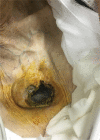Treatment of Infected Cardiac Implantable Electronic Devices
- PMID: 27152097
- PMCID: PMC4856529
- DOI: 10.1055/s-0036-1580733
Treatment of Infected Cardiac Implantable Electronic Devices
Abstract
With their rising benefits, cardiac implantable electronic devices (CIEDs) such as pacemakers and left ventricular assist devices (LVADs) have witnessed a sharp rise in use over the past 50 years. As indications for use broaden, so too does their widespread employment with its attendant rise of CIED infections. Such large numbers of infections have inspired various algorithms mandating treatment. Early diagnosis of inciting organisms is crucial to tailoring appropriate antibiotic and or antifungal treatment. In addition, surgical debridement and explant of the device have been a longstanding modality of care. More novel therapies focus on salvage of the device by way of serial washouts and instilling drug-eluting antibiotic impregnated beads into the wound. The wound is then serially debrided until clean and closed. This technique is better suited to patients whose device cannot be removed, patients who are poor candidates for cardiac surgery, or patients who have failed conventional prior treatments.
Keywords: antibiotic beads; cardiac implantable electronic devices; infection; left ventricular devices; salvage therapy.
Figures





Similar articles
-
Attempted salvage of infected cardiovascular implantable electronic devices: Are there clinical factors that predict success?Pacing Clin Electrophysiol. 2018 May;41(5):524-531. doi: 10.1111/pace.13319. Epub 2018 Apr 3. Pacing Clin Electrophysiol. 2018. PMID: 29518265
-
Cardiac implantable electronic device removal in patients with left ventricular assist device associated infections.J Cardiovasc Electrophysiol. 2014 Nov;25(11):1199-205. doi: 10.1111/jce.12461. Epub 2014 Jul 8. J Cardiovasc Electrophysiol. 2014. PMID: 24890850
-
Management of cardiac implantable electronic devices in the presence of left ventricular assist devices.Heart Rhythm. 2018 Jul;15(7):1089-1096. doi: 10.1016/j.hrthm.2018.01.017. Epub 2018 Jan 8. Heart Rhythm. 2018. PMID: 29325978 Review.
-
Prevention of Cardiac Implantable Electronic Device Infections: Single Operator Technique with Use of Povidone-Iodine, Double Gloving, Meticulous Aseptic/Antiseptic Measures and Antibiotic Prophylaxis.Pacing Clin Electrophysiol. 2017 Jan;40(1):26-34. doi: 10.1111/pace.12996. Epub 2017 Jan 17. Pacing Clin Electrophysiol. 2017. PMID: 27996097 Clinical Trial.
-
Cardiac implantable electronic device infection.Cleve Clin J Med. 2017 Dec;84(12 Suppl 3):47-53. doi: 10.3949/ccjm.84.s3.05. Cleve Clin J Med. 2017. PMID: 29257738 Review.
Cited by
-
Rare case of implantable cardioverter defibrillator infection caused by Stenotrophomonas maltophilia and Pantoea calida.BMJ Case Rep. 2019 Aug 30;12(8):e230506. doi: 10.1136/bcr-2019-230506. BMJ Case Rep. 2019. PMID: 31471361 Free PMC article.
-
Mesoporous Silica Materials as Drug Delivery: "The Nightmare" of Bacterial Infection.Pharmaceutics. 2018 Dec 15;10(4):279. doi: 10.3390/pharmaceutics10040279. Pharmaceutics. 2018. PMID: 30558308 Free PMC article. Review.
-
A review on antimicrobial strategies in mitigating biofilm-associated infections on medical implants.Curr Res Microb Sci. 2024 Mar 7;6:100231. doi: 10.1016/j.crmicr.2024.100231. eCollection 2024. Curr Res Microb Sci. 2024. PMID: 38510214 Free PMC article. Review.
-
Ventricular Assist Device-Specific Infections.J Clin Med. 2021 Jan 25;10(3):453. doi: 10.3390/jcm10030453. J Clin Med. 2021. PMID: 33503891 Free PMC article. Review.
-
Proteus mirabilis: An Unlikely Device-related Infection.J Community Hosp Intern Med Perspect. 2025 Jan 6;15(1):84-88. doi: 10.55729/2000-9666.1440. eCollection 2025. J Community Hosp Intern Med Perspect. 2025. PMID: 39867149 Free PMC article.
References
-
- Myerburg R J. Implantable cardioverter-defibrillators after myocardial infarction. N Engl J Med. 2008;359(21):2245–2253. - PubMed
-
- Antman E M. Philadelphia: WB Saunders; 2002. Cardiovascular Therapeutics: A Companion to Braunwald's Heart Disease. 2nd ed.
-
- Goldberger Z, Lampert R. Implantable cardioverter-defibrillators: expanding indications and technologies. JAMA. 2006;295(7):809–818. - PubMed
-
- Voigt A, Shalaby A, Saba S. Continued rise in rates of cardiovascular implantable electronic device infections in the United States: temporal trends and causative insights. Pacing Clin Electrophysiol. 2010;33(4):414–419. - PubMed
-
- Kretlow J D, Brown R H, Wolfswinkel E M. et al.Salvage of infected left ventricular assist device with antibiotic beads. Plast Reconstr Surg. 2014;133(1):28e–38e. - PubMed
LinkOut - more resources
Full Text Sources
Other Literature Sources
Research Materials
Miscellaneous

